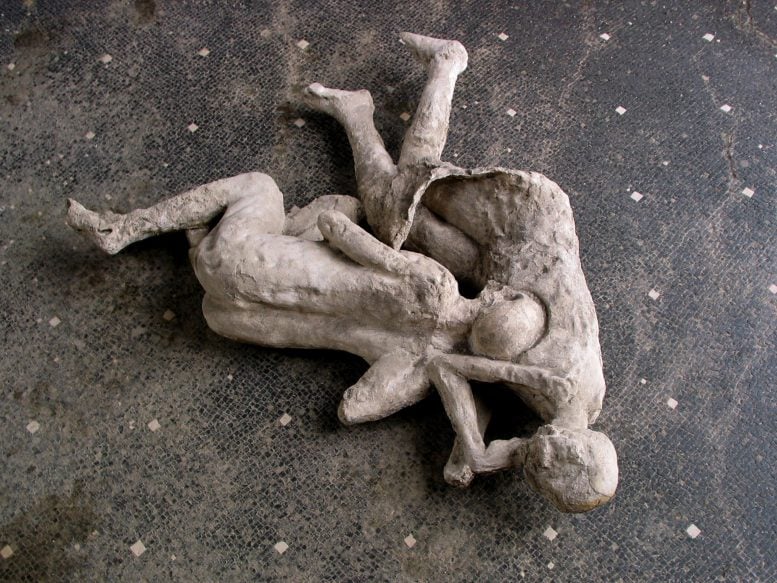A recent genetic study calls for a reexamination of the identities and relationships of several individuals buried and preserved in the ancient Roman city of Pompeii.
A team of international scientists from Harvard Medical School, the University of Florence, and the Max Planck Institute for Evolutionary Anthropology analyzed DNA from the remains of five individuals who perished in the 79 CE eruption of Mount Vesuvius and were later preserved in plaster nearly 2,000 years afterward. The researchers, collaborating with the Archaeological Park of Pompeii, recovered the DNA as part of the restoration of 86 damaged plaster casts in 2015.
New Revelations on Identity and Relationships
The results, published recently in Current Biology, reveal that some of the stories told for decades about the individuals’ sexes and family relationships, which were based on the casts’ physical appearance and other archaeological evidence, are either not correct or not as simple as believed. For example:
- An adult with a golden bracelet and a child on their lap, often interpreted as mother and son or daughter, turned out to be a genetic male and a biologically unrelated child.
- Three of four presumed family members at one site had no genetic ties to one another, at least up to the third degree. (The team wasn’t able to analyze DNA from the remains of the fourth person.)
- Two individuals lying in a position frequently seen as an embrace — previously hypothesized to be sisters, mother, and daughter, or lovers — include at least one genetic male, excluding two of the three common interpretations.
“The findings demonstrate the importance of integrating genetic analysis with archaeological and historical information to enrich or correct narratives constructed based on limited evidence,” said study co-senior author Alissa Mittnik, former research fellow in genetics at HMS who is now a group leader at the Max Planck Institute.

The authors note that such narratives often reflect the worldviews and biases of researchers and other storytellers at the time. In the case of the Pompeii individuals, the genetic insights should serve as a caution not to make deductions about characteristics like sex and kinship based on evidence like jewelry and physical proximity.
Challenges with Preservation and Presentation
Further complicating the picture is that the remains themselves had been moved into different positions and the plaster casts were likely “creatively restored” in the past, the authors said. Some groups of casts reflect the different aesthetic preferences of the historical periods in which they were made, the researchers noted.
The authors warn against making similar mistakes based on the new DNA findings.
“Instead of establishing new narratives that might also misrepresent these people’s experiences, the genetic results encourage reflection on the dangers of making up stories about gender and family relationships in past societies based on present-day expectations,” said co-senior author David Reich, professor of genetics in the Blavatnik Institute at HMS and professor of human evolutionary biology at Harvard University.
This is true both at Pompeii and at any historic or prehistoric site in the world, Reich added.
The analysis does corroborate previous evidence that ancient Pompeiians largely descended from people who had immigrated from the eastern Mediterranean.
“This underscores the cosmopolitanism of the Roman Empire in this period,” said Reich.
Pompeii Park has included ancient DNA analysis of humans and animals in its study protocols for years, said director Gabriel Zuchtriegel — augmenting other types of data to form a comprehensive, updated interpretation of the site’s archaeological findings and to develop new research methods that advance understanding of the past.
Reference: “Ancient DNA challenges prevailing interpretations of the Pompeii plaster casts” by Elena Pilli, Stefania Vai, Victoria C. Moses, Stefania Morelli, Martina Lari, Alessandra Modi, Maria Angela Diroma, Valeria Amoretti, Gabriel Zuchtriegel, Massimo Osanna, Douglas J. Kennett, Richard J. George, John Krigbaum, Nadin Rohland, Swapan Mallick, David Caramelli, David Reich and Alissa Mittnik, 7 November 2024, Current Biology.
DOI: 10.1016/j.cub.2024.10.007
This work was funded in part by the Italian Ministry of Research (PRIN grant 2020HJXCK9), the European Union (grant Next Generation EU — PNRR M4C2 — Investimento 1.3. PE5-Change), the U.S. National Institutes of Health (grant HG012287), the John Templeton Foundation (grant 61220), the Allen Discovery Center program (a Paul G. Allen Frontiers Group advised program of the Paul G. Allen Family Foundation), and a gift from J.-F. Clin. Reich is an Investigator of the Howard Hughes Medical Institute.
This post was originally published on here







